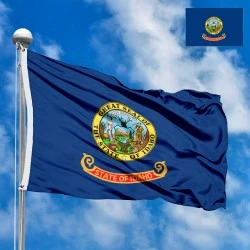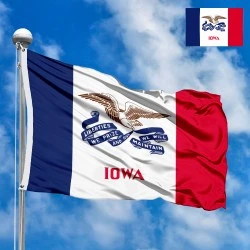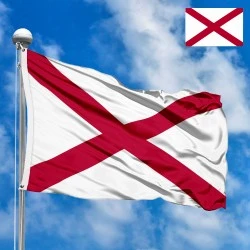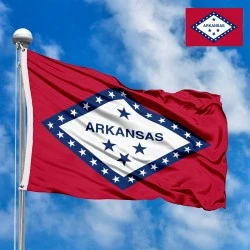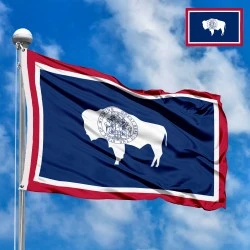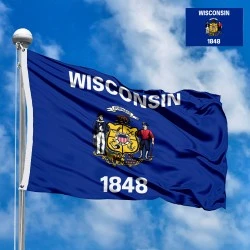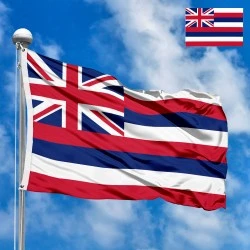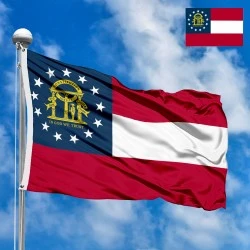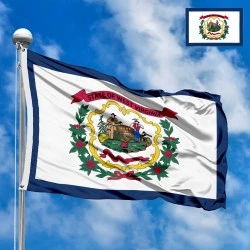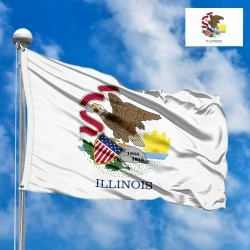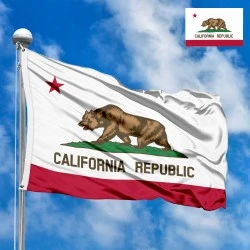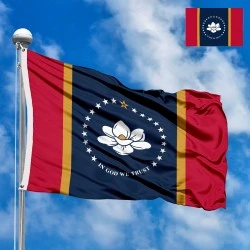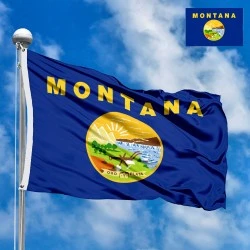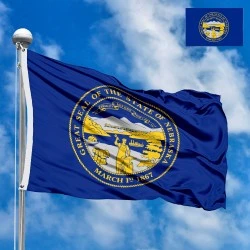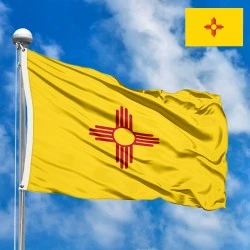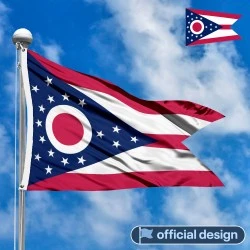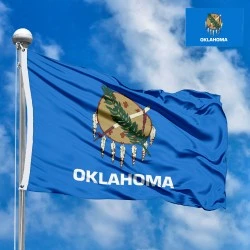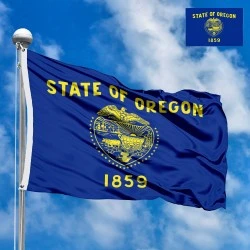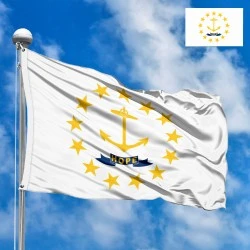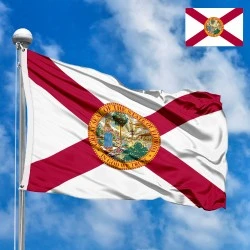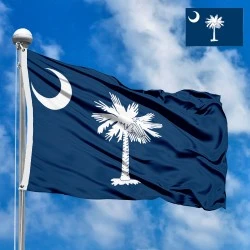Flag of Arizona (US state)
- Flag Type: US States
- Proportions (official): 2:3
- Official name: State of Arizona
- Local name: Arizona
- Capital: Phoenix
- Large cities: Phoenix, Tucson, Mesa
- Population: 7 511 617 (2024)
- Area (km²): 295 234
- Highest point: Humphreys Peak (3,852 m)
- Lowest point: Colorado River (21 m)
- Dialing code: +1 (480, 520, 602, 623, 928)
Flag Information
General information
Demography and Culture
Economy and communications
- All Flags
- Flags of Countries by Continent
-
Flags of Organizations
- Flags of UN countries
- Flags of the European Union countries
- Flags of NATO countries
- Flags of the countries of the Organization of Islamic Cooperation
- Flags of the countries of the Organization of American States
- Flags of the Arab League countries
- Flags of the African Union countries
- Flags of the countries of the Union of South American Nations
- Flags of the Commonwealth of Nations
- Flags of the countries of the Secretariat of the Pacific Community
- Flags of the Nordic Council countries
- Flags of the Caribbean Community
- Flags of the countries of the Association of Southeast Asian Nations
- Flags of the East African Community
- Flags of the countries of the Organization of Turkic States
- LGBT Community Flags
- Historical Flags
- Ethnic Flags
- Flags of the USA (states)
Description
The flag of the state of Arizona is one of the most distinctive and visually striking of all U.S. state flags. Its design is a unique blend of national symbolism, regional heritage, and economic pride. Adopted on February 17, 1917, the flag tells a powerful story of Arizona's place in the Union, its rich cultural past, and the natural resources that define it.
Flag Design, Symbolism, and Colors
The Arizona flag is divided into two distinct halves and a central emblem, each with specific meaning.
-
The Top Half: The upper half of the flag features a magnificent sunburst with 13 alternating rays. These rays are colored in a pattern of red and gold (a deep yellow). The 13 rays represent the thirteen original colonies, a direct link to the founding of the United States. The colors red and gold are a powerful nod to the state’s Spanish heritage and its early history under Spanish rule, as they are the colors of the Spanish national flag.
-
The Bottom Half: The lower half of the flag is a solid field of dark blue. This color is meant to represent the liberty and unity of the American people, as well as the brilliant blue skies that are characteristic of Arizona. It grounds the flag in its national identity.
-
The Central Copper Star: Centered on the flag, where the two halves meet, is a large, vibrant copper-colored star. This star is the most significant symbol of the state's economy. Arizona is known as "The Copper State" and has historically been the leading producer of copper in the United States. The star is a direct tribute to this vital industry and the wealth it has brought to the state.
A Brief History of the Flag's Creation and Adoption
The creation of the Arizona flag is an interesting tale of an impromptu design for a national event that later became an official state symbol.
-
The Rifle Match of 1910: The flag was first designed in 1910 for the Arizona rifle team competing at the National Rifle Match in Ohio. At the time, Arizona was still a territory and lacked a unique emblem. The team's captain, Colonel Charles W. Harris, worked with other members to create a banner that would represent the territory. They chose a sunburst to symbolize the state's nickname, "The Sunshine State," and a copper star to reflect its primary industry.
-
Legislative Debate and Adoption: The design was well-received, and a bill was introduced to the state legislature in 1917 to make it the official flag. The bill was met with some opposition, particularly from then-Governor Thomas E. Campbell, who refused to sign it. However, the legislature passed the bill without his signature on February 17, 1917, making the design the official state flag.
Historical Context and the State of Arizona
The Arizona state flag is a unique historical document. It beautifully marries the state’s different influences—Spanish and Mexican heritage, Native American history, and its American identity. The sunburst represents the state's famously sunny climate and its Native American sun symbols, while the copper star connects it to its industrial and economic history. The flag is a powerful representation of a state forged from a blend of cultures, natural wonders, and economic endeavors.
Significance for Residents
For the people of Arizona, the flag is a strong source of pride. The sunburst represents the state’s bright future and its natural beauty. The copper star is a symbol of hard work and prosperity, honoring the miners and the industry that built much of the state. The colors red, gold, and blue tell a story of the state’s history, reminding residents of their unique heritage and their place in the nation. The flag is a banner that unites them under a shared identity of resilience, natural beauty, and economic strength.
Interesting Facts
-
The flag was designed for a rifle competition, not for general state use.
-
It was ranked as the sixth-best U.S. state flag in a 2001 survey by the North American Vexillological Association.
-
The flag’s designer, Colonel Charles W. Harris, collaborated with a few others on the design, and it was sewn by a local seamstress named Nan D. D. Jones.
-
The governor of Arizona at the time, Thomas E. Campbell, refused to sign the bill to make it an official flag, but it became law anyway because the legislature passed it.
-
The flag’s colors of red and gold are a direct reference to the Spanish flag, a nod to Arizona’s early history.
-
The copper star is a direct and powerful symbol of the state's main industry, distinguishing it from most other state flags that often use simple seals.
In the demonstration images, full-size flags are shown with proportions of 2:3, and hand-held flags with proportions of 1:2.
Donation
Download
Completely free for commercial and non-commercial use (public domain).
You can freely use them in your news magazines, websites, software, mobile applications.
We appreciate a backlink to https://flagssite.com
Raster files - Flag of Arizona (US state) (PNG, JPG)
 Waving flag
Waving flag
- PNG format (transparent background), 72dpi, dimensions in Pixels (px), aspect ratio 3:4.
- 15х20 px
- 30х40 px
- 60х80 px
- 120x160 px
- 240x320 px
 Sizes:
Sizes:
"v15" - image size (by height); if necessary, replace with available: v15, v30, v60, v120, v240.
!!! For resizing, use the Latin (eng) keyboard layout.
<img src="https://flagssite.com/flags/v15/20547.png" alt="Flag of Arizona (US state)">
 Round flag
Round flag
- PNG format (transparent background), 72dpi, dimensions in Pixels (px), aspect ratio 1:1.
"d15" - image size (diameter); if necessary, replace with available: d15, d30, d60, d120, d240.
!!! For resizing, use the Latin (eng) keyboard layout.
<img src="https://flagssite.com/flags/d15/20547.png" alt="Flag of Arizona (US state)">
 Rectangular flag 2:3
Rectangular flag 2:3
- JPG format, 72dpi, dimensions in Pixels (px), aspect ratio 2:3.
"h30" - image size (by height); if necessary, replace with available: h15, h30, h60, h120, h240, h360, h480.
!!! For resizing, use the Latin (eng) keyboard layout.
<img src="https://flagssite.com/flags/h30/20547.jpg" alt="Flag of Arizona (US state)">








 Sizes:
Sizes:
 Sizes:
Sizes:
